lordroel
Administrator
Member is Online
Posts: 67,966 
Likes: 49,369
|
Post by lordroel on Aug 7, 2019 2:53:11 GMT
Day 11 of the Great War, August 7th 1914
Youtube (Germany in Two-Front War and the Schlieffen-Plan)
HMCS CC-1 and CC-2, the first two Canadian submarines are commissioned. Photo: Submarine CC1 in the Esquimalt Slips
 East Prussia: First Russian Army, under Rennenkampf, crosses the frontier in force. Bosnia entered by the Serbians. Germany: Kaiser issues proclamation to his people. The French Army launches an offensive into Alsace. The Germans capture the Citadel of Liège, but the Belgian forts remain in action. Map: the fortified position of Liège. The forts built between 1888 and 1891 are in blue (PFL II), the forts built in the 1930s in red (PFL I)
 A Contemptible Little Army A Contemptible Little Army
In pre-war agreements, it had been agreed between Britain and France that the British army should immediately sail to France if war with Germany broke out. This British Expeditionary Force, the BEF, would form the left wing of the French line. Unlike the other Great Powers, Britain did not have a large conscript army. The British army was a small force composed entirely of professional soldiers. As Britain had always relied on the Royal Navy for security, there was no need for a large standing army. The British army in 1914 was composed of 250,000 regulars and 220,000 reservists, formed into six infantry divisions and one cavalry division. Worried about committing their entire force to the war, Britain sent four of these divisions and the cavalry to France on August 7th. Despite the small size of this force, it’s highly-trained professional nature meant that it punched far above its weight. However, the panicky nature of its commander, Sir John French, meant that it did not account itself in August 1914 as well as it could have. Compounding this problem was the small size of the BEF, as it could only bear the horrible losses in battle for so long before Britain required new armies. German East Africa
Togoland: after calling on the German colony to surrender on August 6th, French and British troops invaded unopposed the next day. No military personnel was stationed in the protectorate. The police force consisted of a commander and deputy commander, 10 German sergeants, 1 native sergeant and 660 Togolese policemen deployed throughout the territory. The Entente forces occupied the capital Lome, then advanced on a powerful and new radio station near Kamina (east of Atakpamé). Map: German colony of Togoland, 1914

The GOEBEN affair, Part 5
All through that night Rear-Admiral Troubridge raced south with his four armoured cruisers, accompanied by the light cruiser DUBLIN, commanded by Captain John Kelly, Howard's older brother. At 02:54 on 7 August, Troubridge sent a signal giving his course and speed, and included the message "Am endeavouring to cross GOEBEN'S bows at 6:00 A.M.". Some time later Troubridge was approached by Fawcett Wray, captain of Troubridge's flagship, DEFENCE. Wray asked the Admiral "Are you going to fight, sir? Because if so the squadron ought to know". Later, Wray again talked to Troubridge, explaining that he believed that an attack on GOEBEN would be suicide, even with four heavy cruisers. Troubridge replied "I cannot turn away now; think of my pride". Wray answered "Has your pride got anything to do with this, sir? It is your country's welfare that is at stake." Troubridge asked his navigator if there was any chance at all of getting close enough to even hit the German ship. The navigator said there was no chance whatsoever. When Troubridge called off the chase, Wray told him "Admiral, that is the bravest thing you have ever done in your life". At 04:49 Troubridge telegraphed Milne that he had turned back. Milne replied "Why did you not continue to cut off GOEBEN? She was only going 17 knots, and so important to bring her to action". At 08:30 Troubridge sent this reply: "With visibility at the time I could have been sighted from 20 to 25 miles away and could never have got nearer unless GOEBEN wished to bring me to action which she could have done under cicumstances most advantageous to her. I could never have brought her to action. I had hoped to have engaged her at 3:30 in the morning in dim light but had gone north first with the object of engaging her in the entrance of the Adriatic. I was too late to intercept her when she altered course to the southward. In view of the immense importance of victory or defeat at such early stage of a war I would consider it a great imprudence to place my squadron in such a position as to be picked off at leisure and sunk while unable to effectively reply. The decision is not the easiest of the two to make I am well aware". Milne ordered Troubridge to take his force back to the Adriatic to watch the Austrians, and himself took up station again south of Sicily, still thinking Souchon would try to escape to the Atlantic. At 17:00 hours on 10 August, GOEBEN and BRESLAU anchored off Cape Helles. Souchon asked for a pilot to guide him through the Turkish minefields, and then sailed up the Dardanelles to Constantinople. The Turks were overjoyed to have the German ships, as the two battleships they had under construction in England had just been siezed by the British, to become HMS AGNINCOURT and ERIN. When informed of the escape of the German ships, First Sea Lord Prince Louis of Battenberg said "Not one of the excuses which Admiral Troubridge gives can be accepted for one moment. The escape of the GOEBEN must ever remain a shameful episode in the war". Admiral Lord John 'Jackie' Fisher (who had been First Sea Lord and would be again) called Milne "...a serpent of the lowest order", and said in a letter "Personally I would have shot Sir Berkely Milne", and added "...he had no excuse whatever for not surrounding Messina with all his entire force right round the harbour mouth-close up! As if international law mattered a d--n!! And the Italians would have loved him forever!" Also the Austro-Hungarian fleet sortied a squadron to support the German ships GOEBEN and BRESLAU in case they attempted to make their way up the Adriatic. 1st Battleship Division: TEGETTHOFF (Vice-Admiral Njegovan), VIRIBUS UNITIS and PRINZ EUGEN. 2nd Battleship Division: ERHERZORG FRANZ FERDINAND (Rear-Admiral Willenik), RADETZKY and ZRINYI. Cruiser: SANKT GEORG. 2nd Torpedo Flotilla:ADMIRAL SPAUN, CEPEL, CISIKOS, DINARA, SCHARFSCUTZE,VELEBIT,WILDFANG, 50E, 51T, 56T, 57T, 58T, 60T, 61T, 65T, 66F, 67F, 74T, 75T and 76T. Asian and Pacific Theatre of the Great War
VADM Sir George Patey, RN, wrote the first wartime order for the RAN, and for that matter the Commonwealth of Australia, whilst onboard his flagship, HMAS AUSTRALIA, (battle-cruiser). It was Operational Order No. 1, headed ‘Intention’. Photo: HMAS AUSTRALIA at sea in 1913.

|
|
lordroel
Administrator
Member is Online
Posts: 67,966 
Likes: 49,369
|
Post by lordroel on Aug 8, 2019 2:48:54 GMT
Day 12 of the Great War, August 8th 1914
Russian 1st Army under General Paul von Rennenkampf and 2nd Army under General Alexander Samsonov enter East Prussia. British government requests its ally, Empire of Japan, to enter the war against Germany. German IX, X, and VII Corp under the command of General Karl von Einem is ordered into Belgium. British government attempt to suppress the “alarming unrest” in India, as pro-independence sentiments grow. Tsar Nicholas lauds the zeal of the Russian people in a speech to the Duma and states the “enormous enthusiasm” is guarantee of victory. Antivari (Montenegro) bombarded by Austrian fleet. Switzerland mobilises and proclaims state of siege. Austrian authorities arrest a suspected Russian spy in the town of Neumarkt (renamed Targ in 1919), in Galicia. His name is Vladimir Lenin. Austrian Social Democrat leader Victor Adler tells the government that if released Lenin would likely mount a propaganda campaign against the Tsar. The Austrian authorities let Lenin go and he moves to Switzerland. Liberation of Mulhouse
Alsace and Lorraine were annexed by Germany after the Franco-Prussian War, and France spent the period between the two wars brooding on revenge. When the Great War broke out the first French offensive was launched into Alsace. French General Bonneau’s VIIth Corps, detached from France’s rightmost army, General Dubail’s First, had the glory of launching France’s first attack of the war, sweeping down into picturesque Alsace on the 7th of August. Charging down the slopes of the Vosges in a perfectly ordered bayonet charge, the French soldiers brushed aside light German resistance. It was planned to keep on advancing towards the Rhine, where the French would destroy the bridges and defend their newly liberated provinces. On the 8th, Bonneau’s troops triumphantly entered the Alsatian town of Mulhouse. Bands played “The Marseillaise”, flags waved in the breeze, and French infantry and beautifully ornamented cavalry in shining armour and with long horsehair plumes paraded through the town, to the joy of the inhabitants. But not all the citizens thrust gifts and kisses at the liberators. Some of the townsfolk were German settlers, who grimly watched the French parade, and then hurried away to inform the German army of what they had seen. German East Africa
Steaming parallel to the coast, Captain Alfred Sykes in HMS ASTRAEA lobs several salvos on the shore installations at Dar-es-Salaam and sends an armed party into the harbor. Commissioned in 1894, Astraea is on her last legs, and her outdated armament of two obsolescent 6-inch and eight 4.7-inch weapons are of little military consequence. Still she is more than adequate for the task at hand. This is done as part of Rear Admiral Herbert King-Hall’s, Commander in Chief of the Cape Station plan to deprive SMS KONINGSBERG of supplies, most importantly coal. The wireless station is destroyed and the German merchantmen KONING and FIELD MARSCHALL are damaged. A curious truce is signed: the Captain of the ASTRAEA agrees that the Royal Navy will not attack the town and the local German authorities agree to refrain from all hostile activities for the duration of the war, and the town settles back into is pre-war ways. The German harbormaster hurriedly orders his floating dock towed out and scuttled across the harbor entrance. His hastily and ill-considered response provides the ASTRAEA with a greater victory than King-Hall anticipated. By sinking the dock in the deep-water channel, the harbormaster foolishly bottles up the 8,000 ton East Afrika Line’s TABORA – thus depriving KONINGSBERG of a valuable auxiliary cruiser. At the same time, his extemporaneous block ship has cut the cruiser off from her vital coal supply. Photo: picture of HMS ASTRAEA before the war
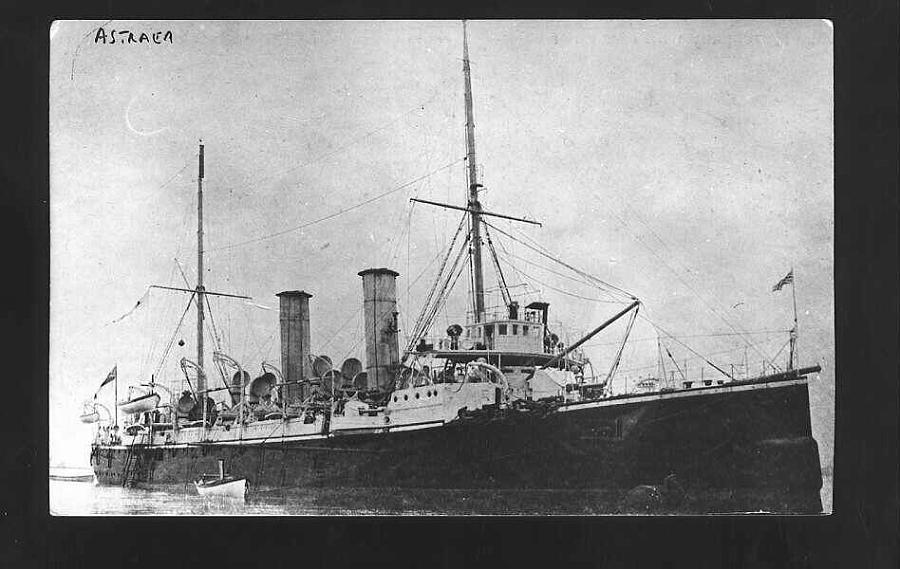 British troops capture the port of Lome, German Togoland.
|
|
lordroel
Administrator
Member is Online
Posts: 67,966 
Likes: 49,369
|
Post by lordroel on Aug 9, 2019 7:07:58 GMT
Day 13 of the Great War, August 9th 1914
KARLSRUHE steams into San Juan, Puerto Rico with only 12 tons of coal in her bunkers. It being a Sunday Captain Köhler has trouble buying coal. Matters are complicated further by British and French consuls claiming Köhler is violating neutrality by trying to purchase 1300 tons of coal. In the end KARLSRUHE ends up with only 500 tons of poor-grade coal. The old German collier PATAGONIA is in port, and Köhler instructs her captain to proceed to St. Thomas and buy a load of coal there. At 2000 hours KARLSRUHE gets under way. Photo: "KARLSRUHE" during fuel bunkering in San Juan
 GOEBEN and BRESLAU coal at the island of Denusa. Light cruiser HMS BIRMINGHAM spots the German submarine U-15, whose engines have failed as she lay stopped on the surface in heavy fog, off Fair Isle. The crew of BIRMINGHAM hear hammering from inside the boat from attempts at repairs, and fire on her but miss. As the U-boat begins to dive, Birmingham rams her, cutting her in two. U-15 goes down with all hands. This is the first encounter between ships of the Grand Fleet and a U-boat, and the first action between surface and under surface craft in history, the first case of a submarine being sunk in such action. Photo: U-15 before the war
 In the battle of Mulhouse, Parts of the XIV and XV Corps of the German 7th Army, arrived from Strasbourgand counter-attacked at Cernay. The German infantry then emerged from the Hardt forest, to advance into the east side of the city. French command broke down and the defenders fought isolated actions, before retiring as best they could, as the German attackers exploited their advantage. United States will allow European reservists to return home and fight as long as they are unarmed and not in uniform. German XIV and XV Corp counterattack French troops at Cernay, who are forced to retreat. Sweden and Norway both reaffirm their neutrality in the present war. Ottoman Empire begins its mobilization. Germany, by means of the Netherlands, offers terms of peace to Belgium; they are rejected. On Lake Nyasa, in Central Africa, Commander Edmund L Rhoades sails his gunboat the GWENDOLEN with its single 3-pounder gun across the lake from the British port of Nkata Bay to the tiny German port of Sphinxhaven, 30 miles away. There he opens fire on and captures the German gunboat WISSMAN whose commander has not yet heard that war has been declared. Conducting a reconnaissance mission, the French dirigible (airship) Fleurus became the first British-French aircraft to fly over Germany sins the start of the war. Photo: dirigible (airship) Fleurus before the war.

|
|
lordroel
Administrator
Member is Online
Posts: 67,966 
Likes: 49,369
|
Post by lordroel on Aug 10, 2019 6:11:10 GMT
Day 14 of the Great War, August 10th 1914After evading British warships in the Mediterranean, the German battle cruiser GOEBEN and light crusier BRESLAU arrived off the entrance to the Dardanelles and requested Turkish permission to enter the straits. The Turks let the German warships through to Constantinople where they were nominally handed over to the Turkish navy. Map of pursuit and escape of German warships GOEBEN and BRESLAU to Ottoman Empire
 The French 14è Hussards (Hussars) moved out in the direction of Pillon and Arrancy (north east of Mangiennes). Advancing over the hill in front of the French lines they came across a large column of Germans coming down the far side of the valley towards Pillon. The Hussars deployed their machine guns and opened up on the German infantry at 1500 metres and thus began the first battle on French soil since the Franco-Prussian War. Japanese Emperor ends his vacation and returns to Tokyo in anticipation of war. Germany occupies the city of Liege. Russians reach Tilsit in East Prussia. Austrian First Army, under Dankl, enters Poland and advances towards Lyublin and Kyeltsi. France severs diplomatic relations with Austria-Hungary, due to the presence of Austrian troops in Germany Austro-Hungarian army enters Volhynia, Russian Poland and captures a few border towns. Austro-Hungarian navy bombards the Montenegrin port in Bar. German forces raid the Cape Colony from South West Africa, but abandon militarily Swakopmund and Luderitz Bay, in South West Africa. Germans living in Australia declared ‘enemy aliens’ and required to report to their nearest police station. French Abandon MulhouseDespite the triumphal entry of French soldiers into the town of Mulhouse in Alsace only days before, on August 10th it was decided to abandon the town. The offensive of General Bonneau’s VIIth Corps had not been as successful as hoped, and German reinforcements had been rushed into Alsace to counterattack. It was decided that Mulhouse was too exposed, and to the horror of its inhabitants the French troops glumly marched out on August 10th. Those inhabitants who had celebrated the liberation too happily would suffer from German reprisals. French C-in-C General Joffre accused General Bonneau of being too tentative, and replaced him with General Pau, a one-armed veteran of 1870. Pau’s command was increased to be a small army in its own right, the Army of Alsace. Elated by their success, the Germans would end up committing more men to their left flank than Schlieffen had wanted. Whereas Schlieffen’s last words were purportedly “Keep the right flank strong!” the Germans began to bastardize his plan and push reinforcements to their left. Picture: a German Soldier’s Illustration of the Combat in Alsace
 Asian and Pacific Theatre of the Great War Asian and Pacific Theatre of the Great War
An Australian Government Order-in-Council was gazetted placing all Commonwealth Naval Forces, including the Naval Board, under British Admiralty control. Recruiting offices in Australia open to commence the build up ooh the 1st AIF (Australian Imperial Force).
|
|
lordroel
Administrator
Member is Online
Posts: 67,966 
Likes: 49,369
|
Post by lordroel on Aug 11, 2019 6:39:23 GMT
Day 15 of the Great War, August 11th 1914
Before the Germans can approve this, the Ottomans announce that they have purchased the GOEBEN and BRESLAU for 80 million Marks. Silhouettes of the warships of the Ottoman Navy, as projected for 1914 (including the undelivered dreadnought SULTAN OSMAN-İ EVVEL who was seized by the Royal Navy in August 1914)
 SMS KARLSRUHE arrives at Curacao, Netherlands Caribbean to coal. The German naval and merchant services code was captured from the German vessel HOBART, (merchant ship), at Port Phillip, VIC. The boarding officer, CAPT J. T. Richardson, RN, used a subterfuge to allow the German Captain to retrieve the codes from their hiding place. Richardson seized the books at gunpoint as they were about to be thrown overboard Belgian cavalry repulses German cavalry in the Battle of Haelen. Austro-Hungarian forces launch a major offensive into Serbia, crossing the Drina and the Sava in several places. Asian and Pacific Theatre of the Great War
HMAS AUSTRALIA and the Australia Squadron, under VADM Sir George Patey, RN, arrived in St Georges Channel, near Rabaul, on a search for ADML von Spee’s forces. River-class torpedo-boat destroyers PARRAMATTA, YARRA, and WARREGO launched a night torpedo attack on the German anchorage in Simpsonhaven, New Britain only to find the port was empty. During the day HMAS AUSTRALIA captured the enemy ship SUMATRA whilst patrolling St Georges Channel. Photo: PARRAMATTA leaving harbour circa 1913-14
 Zeppelin attack on Poland Zeppelin attack on PolandGerman army airship Z IV returned to her base at Köningsberg from a successful overnight mission on the Eastern front. Under the command of Hauptmann von Quast, the Zeppelin undertook reconnaissance of the areas around Mława, Gumbinnen, Insterburg, Friedland, Gerdauen and Tilsit. The mission revealed little evidence of Russian forces in or moving through the region. However, while over Mława, Z IV did take the opportunity to drop bombs on the Russian troops encamped there. Photo: German army airship Z IV before the war

|
|
lordroel
Administrator
Member is Online
Posts: 67,966 
Likes: 49,369
|
Post by lordroel on Aug 12, 2019 2:55:08 GMT
Day 16 of the Great War, August 12th 1914A British expedition lands at Lomé, Togoland. Admiral Thomas H M Jerram with the heavy cruisers HMS MINOTAUR and HMS HAMPSHIRE and the light cruiser HMS NEWCASTLE arrives off Yap in the hope of finding Admiral Graf von Spee’s squadron. The German coal steamer ELSBETH is scuttled by her commander and the British, after warning the people on the island to get clear, shell the mast of the powerful and important German radio station until it is destroyed. They then sail away without landing. The German light cruiser SMS EMDEN met up with German Imperial Navy Admiral Maximilian von Spee led East Asia Squadron at Pagan, one of the Mariana Islands in the north Pacific Ocean. The two naval officers agreed to have the EMDEN to stay behind in the eastern Pacific as an independent raider while the bulk of the East Asia Squadron moving towards South America. The submarine U-13 having left Heligoland on August 6th is lost. She may have been a victim of the German defensive minefield in Heligoland Bight, or from an accident or mechanical failure. Photo: SM U-13 in the Harbour of Kiel (first boat left), photo taken before the war.
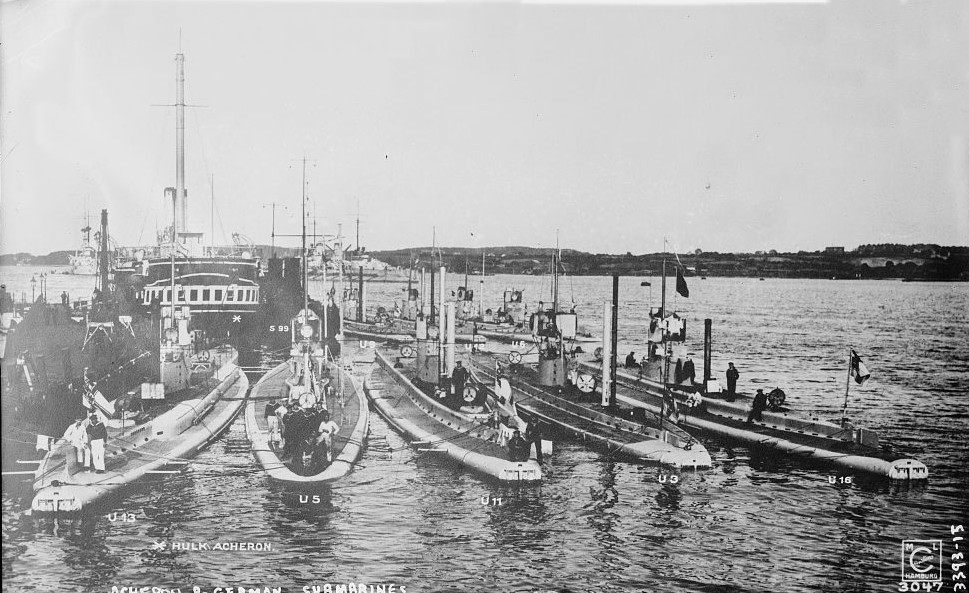 Belgium troops under Léon de Witte successfully defend the town of Haelen from German cavalry led by Georg von der Marwitz. Belgium suffers 480 casualties while Germany suffers 750 casualties and 300 captured. Austro-Hungarian 5th and 6th armies, with 270,000 men, begin crossing the Serbian border across the Drina River. Prince George of Serbia is wounded during an Austrian bombardment of Belgrade. The first troops of the British Expeditionary Force reach France after crossing the English Channel. Battalions of the 19th Brigade are accorded a tremendous reception by the French. These initial troops land at Le Havre, are sent to guard the lines of communication and they will remain in camp until the entire brigade is formed. German Siege Artillery Arrives at LiègePhoto: An Austrian siege gun in Belgium, used along with German howitzers to blast the Liege forts. 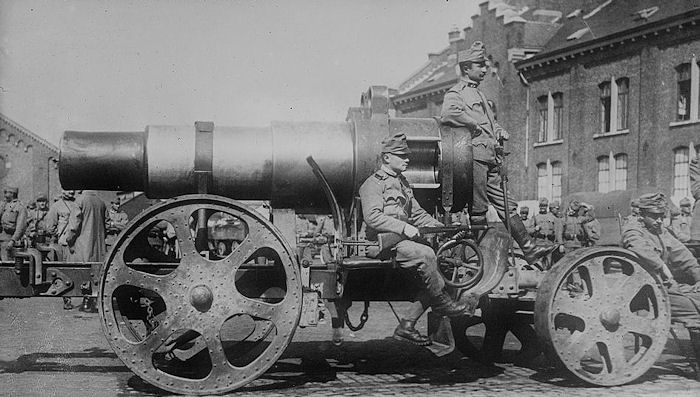 Despite the surrender of the city proper days before and constant attacks, most of the twelve forts around Liège still held on the 12th of August. The world’s press spoke of the forts as an impenetrable obstacle for the Germans. Things changed that day, however, as two Krupp 420mm super heavy siege howitzers arrived, as well as eight Austrian-made Skoda 305mm guns. Transported in sections, the heavy weapons were set up around the forts that afternoon, which required making concrete bases to withstand the shock of firing. At 6:30 pm, the first Krupp gun prepared to fire. The crew stood 300 yards away and fired the gun electronically, making sure to keep their mouths open so their eardrums wouldn’t rupture. The shell traveled the 4km to its target in 60 seconds, and though it missed the gun crew steadied their aim by “walking” the shots up to the fort. When the first shell struck home it demolished a large portion of the Belgian fort and incinerated dozens of its defenders. Others suffocated in the fumes amidst the wreckage. United Kingdom declares war against Austria-Hungary
Britain has officially declared war on Austria. The declaration followed a request from the French government to the British government to communicate to the Austrian-Hungarian Ambassador a declaration indicating the reasons which have resulted in the breaking off in diplomatic relations between France and Austria. ‘Having declared war on Serbia and having thus first taken the initiative in the hostilities in Europe, the Austro-Hungarian government, without any provocation from the government of the French Republic, placed itself in a state of war with France.’
Following this the British government felt obliged to announce that a state of war exists between Britain and Austria from midnight tonight. Newspaper: The Washington Herald

|
|
lordroel
Administrator
Member is Online
Posts: 67,966 
Likes: 49,369
|
Post by lordroel on Aug 13, 2019 2:48:42 GMT
Day 17 of the Great War, August 13th 1914German check at Eghezee; Neufchateau occupied by Crown Prince. British naval forces bombard and raid Dar-es-Salaam. Germany releases Archer Huntington, president of the American Geographical Society, who was detained on suspicions of spying. Germany protests against the U.S. ban on wireless communications between America and Germany. Life insurance companies in the U.S. refuse to offer business to reservists or Canadians due to war risk. Austro-Hungarian navy begins its blockade of Montenegro. Around 60,000 Dutch troops mass on the German border and large areas are flooded as a precautionary measure against an invasion. Russia announces that its concentration of forces on the Galician frontier is complete and is ready for an offensive. Queen Elisabeth of Belgium spends 6 hours today visiting wounded soldiers in military hospitals. Still at Pagan Island, Maximillian von Spee decides to take his squadron around Cape Horn and into the Atlantic. Karl von Müller, captain of the light cruiser EMDEN is ordered to take his ship to the Indian ocean and do what damage he can to Allied shipping there. Photo: EMDEN in early 1914 before the outbreak of war in the German port of Tsingtao
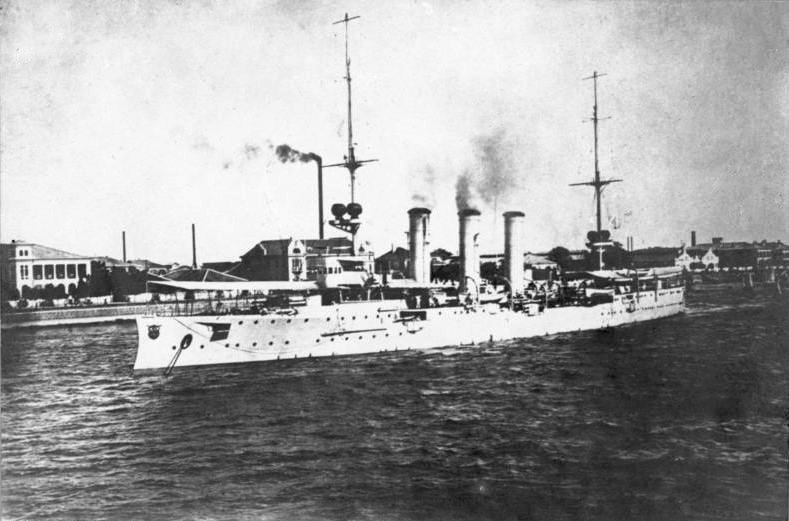 Royal Flying Corps arrives in France Royal Flying Corps arrives in France
Royal Flying Corps Number 2 Squadron, under the command of Major Charles James Burke, is ordered to be the first group of British pilots in France. Flying B.E.2s they took off from Dover at about 06:25. One of the pilots, Lieutenant Hubert Dunsterville Harvey-Kelly, managed to separate from the rest of the group and arrive ahead of the rest, making himself the first British pilot to land in France. Photo: Lieutenant H D Harvey-Kelly, the first British pilot to land in France after the declaration of war, rests his BE2A near Whitby, Yorkshire, during a stop in a flight south from Montrose

|
|
lordroel
Administrator
Member is Online
Posts: 67,966 
Likes: 49,369
|
Post by lordroel on Aug 14, 2019 3:05:13 GMT
Day 18 of the Great War, August 14th 1914Youtube (Arms! - The Deployment of Troops)
Lt Col Bolton ordered to raise 8th Battalion of the AIF with troops recruited from Ballarat, Ararat, the Western District and Surrey Hills Melbourne. France invades Lorraine. The French push back Germans in northern Alsace and bomb German airsheds at Metz. Russians defeat Austrians at Sokal. Austrians drive Serbians back and occupy Loznitsa. Russia proclamation made promising reconstruction and autonomy of the "Kingdom of Poland". British field marshal John French and General Wilson land in France. The Commander in Chief General ‘Sir’ John Denton Pinkstone French of the British Expeditionary Force lands in Boulogne. In the five days of greatest activity for the BEF, 1,800 special trains are run in Great Britain and Ireland. On the busiest day of all, eighty trains, containing the equivalent of a division, are run into Southampton Docks; the daily average of ships dispatched is thirteen, with an average tonnage of approximately 52,000 tons gross. German light cruiser SMS DRESDEN, operating off the coast of Argentina under the command of Kapitän zur See Fritz Emil von Lüdecke, stops the merchant SS HYADES. Von Lüdecke takes the crew on board his own ship, then sinks the British vessel. DRESDEN'S sister ship, EMDEN, departs Pagan Island for the Indian ocean with collier SS MARKOMANNIA. French aviators attack German Zeppelin hangar
Aviators of the French Aéronautique Militaire attacked the German Zeppelin hangar at Frescaty. Lieutenant Antoine Césari and caporal Roger Prudhommeaux from Escadrille MF.16 took off from Verdun in Farman MF.7s at 5.30 PM. Each aircraft carried a modified 155-mm artillery shell. Although Césari and Prudhommeaux reached the target and released their weapons, neither shell hit the target hangar. The aviators returned home safely from their fruitless mission. The sheds presently house two German army Zeppelins: Z II Ersatz (construction number LZ-9) and Z III (LZ-12). Both airships are considered obsolete, and the German army decommissioned them shortly before Germany entered the war. Photo: LZ-12 in flight before the war

|
|
stevep
Fleet admiral
Posts: 24,832 
Likes: 13,222
|
Post by stevep on Aug 14, 2019 15:51:54 GMT
Day 18 of the Great War, August 14th 1914Youtube (Arms! - The Deployment of Troops)
Actually looked at the video and he's a bit unfair to Austria from what I've read elsewhere. Austrian plans had forces for war with either Serbia or Russia and a 3rd element that could support either front. It was a chaotic mess with a lot of infighting and incompetence, notoriously with Conrad himself but once the decision was made to commit the 3rd element south against Serbia rerouting it back to the NE against Russia was very difficult. After all this was pretty much the same argument the German general staff used when Kaiser Wilhelm asked whether only war with Russia would be practical - 'no everything is set up for an advance into France via Belgium and it would cause chaos and failure to try and change that'.
It should also be noted that one reason why Germany wanted Austria to commit more forces against Russia was because Russia was moblising faster than they expected and they were worried about attacks on their own eastern borders. It was at this point that Vienna found out about the so called Schlieffen Plan and that Germany was sending virtually all their army west against France. Their own plans had assumed that Germany would be splitting its army more equally and contributing substantial forces against Russia itself.
Ironically France - an enemy - knew more about the Schlieffen Plan than Austria - an ally. The problem for France was twofold.
a) They expected the attack to be based further south, coming more through Luxembourg and northern Alsace hence set up their forces there, with only one relatively weak army, fortunately to be joined by the BEF, facing the main weight of the German thrust. b) Their own belief in the superiority of the offensive meant they threw far too many men away in attacks, often on prepared positions. If they had met the Germans head on further north and been more on the tactical defensive fighting would have been very heavy but you might well have seen the Germans defeated and they likely would have been able at best to make only minimal gains.
|
|
lordroel
Administrator
Member is Online
Posts: 67,966 
Likes: 49,369
|
Post by lordroel on Aug 14, 2019 15:57:18 GMT
Day 18 of the Great War, August 14th 1914Youtube (Arms! - The Deployment of Troops)
Actually looked at the video and he's a bit unfair to Austria from what I've read elsewhere. Austrian plans had forces for war with either Serbia or Russia and a 3rd element that could support either front. It was a chaotic mess with a lot of infighting and incompetence, notoriously with Conrad himself but once the decision was made to commit the 3rd element south against Serbia rerouting it back to the NE against Russia was very difficult. After all this was pretty much the same argument the German general staff used when Kaiser Wilhelm asked whether only war with Russia would be practical - 'no everything is set up for an advance into France via Belgium and it would cause chaos and failure to try and change that'. It should also be noted that one reason why Germany wanted Austria to commit more forces against Russia was because Russia was moblising faster than they expected and they were worried about attacks on their own eastern borders. It was at this point that Vienna found out about the so called Schlieffen Plan and that Germany was sending virtually all their army west against France. Their own plans had assumed that Germany would be splitting its army more equally and contributing substantial forces against Russia itself. Ironically France - an enemy - knew more about the Schlieffen Plan than Austria - an ally. The problem for France was twofold.
a) They expected the attack to be based further south, coming more through Luxembourg and northern Alsace hence set up their forces there, with only one relatively weak army, fortunately to be joined by the BEF, facing the main weight of the German thrust. b) Their own belief in the superiority of the offensive meant they threw far too many men away in attacks, often on prepared positions. If they had met the Germans head on further north and been more on the tactical defensive fighting would have been very heavy but you might well have seen the Germans defeated and they likely would have been able at best to make only minimal gains.
Did not know that, but i guess every person has its own view on something. |
|
lordroel
Administrator
Member is Online
Posts: 67,966 
Likes: 49,369
|
Post by lordroel on Aug 15, 2019 2:55:14 GMT
Day 19 of the Great War, August 15th 1914
Newspaper: The Washington Times
 German forces fight a brief delaying action against the advancing British the Lila River, Togoland, while a German raiding party embarked in a pair of trains fight a series of actions with the British around Agbeluvhoe. The French attacks in Alsace and Lorraine continue, with heavy casualties inflicted by the defending Germans. One of them is Lieutenant Charles de Gaulle, wounded at Dinant. More of the Liège forts fall. To the west, German troops begin to cross the Meuse below Huy. The French begin to reorient some of their forces toward the German thrust into Belgium, but continue with plans for offensives in Alsace, Lorraine, and the Ardennes. An Anglo-French conference in London reaches an agreement on a joint attack on Cameroon to be led by a British commander, forty-five year old Brigadier General Charles McPherson Dobell. General von Lettow-Vorbeck hastily concentrates a force of 300 German and native troops at Moshi. In a lightning attack he captures the town of Taveta, British East Africa on the border at the southeast foot of Kilimanjaro threatening the Uganda Railway. Japan ultimatum to Germany
Japan sends and Ultimatum to Germany demanding the removal of all German ships from Japanese and Chinese waters and the surrender of control of Tsingtao—the location of Germany’s largest overseas naval bases, located on China’s Shantung Peninsula—to Japan by noon on August 23rd. The ultimatum stated
We consider it highly important and necessary in the present situation to take measures to remove the causes of all disturbance of peace in the Far East, and to safeguard general interests as contemplated in the Agreement of Alliance between Japan and Great Britain. In order to secure firm and enduring peace in Eastern Asia, the establishment of which is the aim of the said Agreement, the Imperial Japanese Government sincerely believes it to be its duty to give advice to the Imperial German Government to carry out the following two propositions: (1) Withdraw immediately from Japanese and Chinese waters the German men-o'-war and armed vessels of all kinds, and to disarm at once those which cannot be withdrawn. (2) To deliver on a date not later than September 15th, to the Imperial Japanese authorities, without condition or compensation, the entire leased territory of Kiao-chau, with a view to the eventual restoration of the same to China. The Imperial Japanese Government announces at the same time that in the event of its not receiving, by noon on August 23rd, an answer from the Imperial German Government signifying unconditional acceptance of the above advice offered by the Imperial Japanese Government, Japan will be compelled to take such action as it may deem necessary to meet the situation. Battle of CerOn the night of August 15th, fighting erupted on the slopes on Cer Mountain when some elements of the Serbian First Combined Division encountering the Austro-Hungarian outposts that had been established on the slopes of Cer Mountain. The Austro-Hungarian positions were lightly held and their soldiers were driven back away from this mountain. By midnight, fierce clashes had developed between the two armies and the Serbs were underway and chaos ensued in the darkness. Photo: "Mobilized troops of the Austrian "Punishment expedition", sent across Sarajevo, setting out for the "occupation" of Serbia"
 YouTube (Battle of Cer Mountain August 15th - 24th 1914) YouTube (Battle of Cer Mountain August 15th - 24th 1914)
Map showing the initial attacks by the Austrian army against Serbia in August of 1914
![]() ![]() 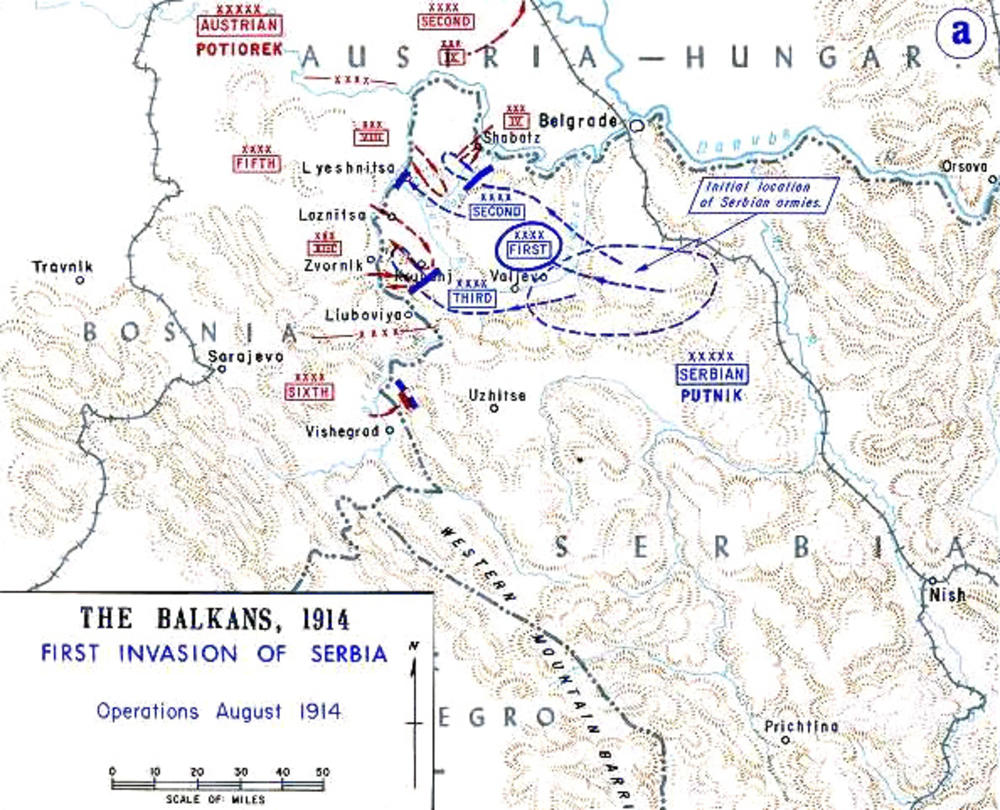
|
|
lordroel
Administrator
Member is Online
Posts: 67,966 
Likes: 49,369
|
Post by lordroel on Aug 16, 2019 7:28:12 GMT
Day 20 of the Great War, August 16th 1914GOEBEN and BRESLAU are commissioned into the Ottoman navy, with GOEBEN becoming its flagship,YAVUZ SULTAN SELIM and and BRESLAU becoming MIDILLI. Photo: former GOEBEN now as YAVUZ SULTAN SELIM
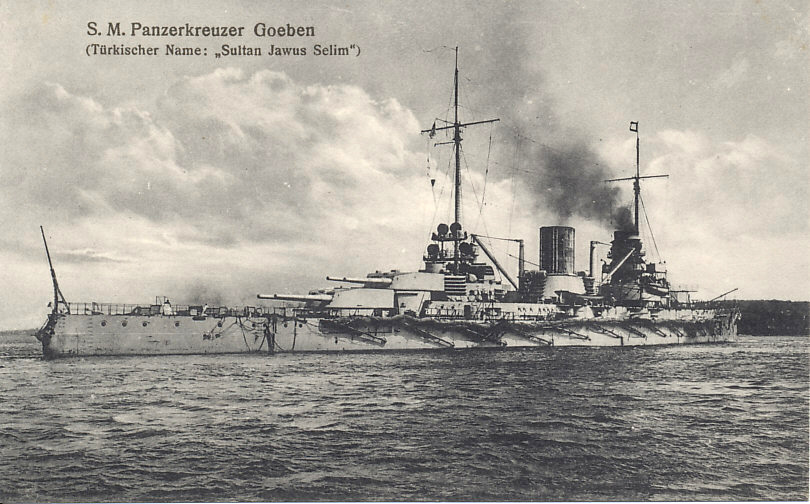 Belgium: Indecisive action at Wavre. B.E.F. first contingent completes its landing in France. This was an Army of 4 Infantry Divisions, with another 2 divisions kept in England in case of an invasion French successful in northern Alsace (Schirmeck, etc.). Battle of Cer: Serbian 1st Combined Division attacks Austro-Hungarian outposts on the slope of Cer Mountain. The Battle of Liège comes to an end with 5300 German casualties and 6000-20,000 Belgian casualties with 4000 prisoners. 2nd Lieutenant Evelyn Perry of the Royal Flying Corps dies in a training accident, making him the first British officer to die in France. Italy withdraws its military contingent from Scutari, Albania to emphasize its neutrality in the war. Off the coast of Venezuela SMS KARLSHURE spots a merchant ship. The ship also sees them and runs northward. Captain Köhler decides that the risk of running into one of Cradock's ships is too great and breaks off the pursuit. Battle of Antivari
Franco-British squadron enters the Adriatic sinking the Austro-Hungarian Navy cruiser SMS ZENTA. The combined Anglo-French Fleet under Admiral Auguste Boué de Lapeyrère, made a sweep of the Adriatic Sea. ZENTA was escorted by a destroyer blockading the coast of Montenegro. She was trapped by seventeen French and British naval units consisting of battleships and armoured cruisers, which prevented her escape North. After allowing the destroyer SMS ULAN to get away, she was sunk by gunfire during the Battle of Antivari off the coast of Bar, Montenegro, with the loss of 179 lives. Surviving commander Paul Pachner, officers and crew swam ashore and were interned until 1916 (the Anglo-French Fleet did not attempt to rescue any survivors). The imprisoned crew were Croats from Blato na Korčuli, Šolta, Tisno, Biograd na Moru, Bogomolje, Rab, Imotski, Hvar, Trogir, Split, Šibenik, Vela Luka, Sali and Zadar and two Montenegrins from Grbalj and Perast. Painting: the battle of Antivari in which SMS Zenta was sunk.
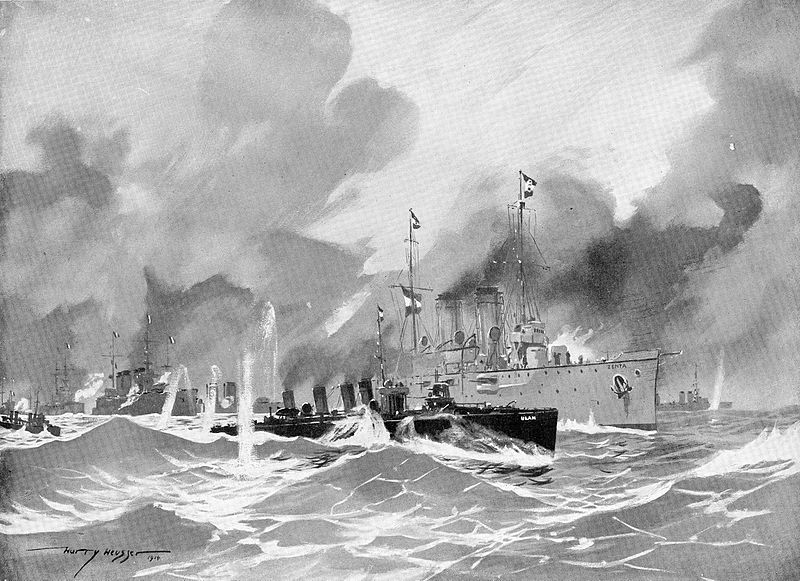 Asian and Pacific Theatre of the Great War Asian and Pacific Theatre of the Great WarMembers of the AN&MEF re-embarked at Thursday Island on Troopship 'KANOWMA' to take part in the capture of German New Guinea. Pelorus-class light cruiser HMAS PIONEER captures the German merchant ship NEUMUNSTER, off Rottnest Island, Western Australia. Photo: HMAS PIONEER before the war
 Final Liège Forts Surrender Final Liège Forts Surrender
The press of Allied and neutral countries still regarded Liège as an impervious position, but by the 16th only one fort still held out. This was Fort Loncin, where Belgian commander Leman made his headquarters. The Germans sent out emissaries to Leman to request his surrender; he refused. The bombardment of Fort Loncin commenced and a shell hit and destroyed the fort’s magazine, causing a tremendous explosion from within. The Germans strolled up to the ruins of the fort that littered the ground, meeting no resistance, and finding the unconscious body of Leman on the ground. Revived and taken to General von Emmich, Leman surrendered his sword. “ I was taken unconscious.” said Leman, “Be sure to put that in your dispatches.” “Military honour has not been violated by your sword,” replied Emmich and handed it back. “Keep it.”
The defiance of the Liège forts was over. The Germans had been held up at Liège for weeks, but as their march through Belgium was not scheduled to begin until the 15th, they had lost only two days. Photo: Germans in the Ruins of Fort Loncin
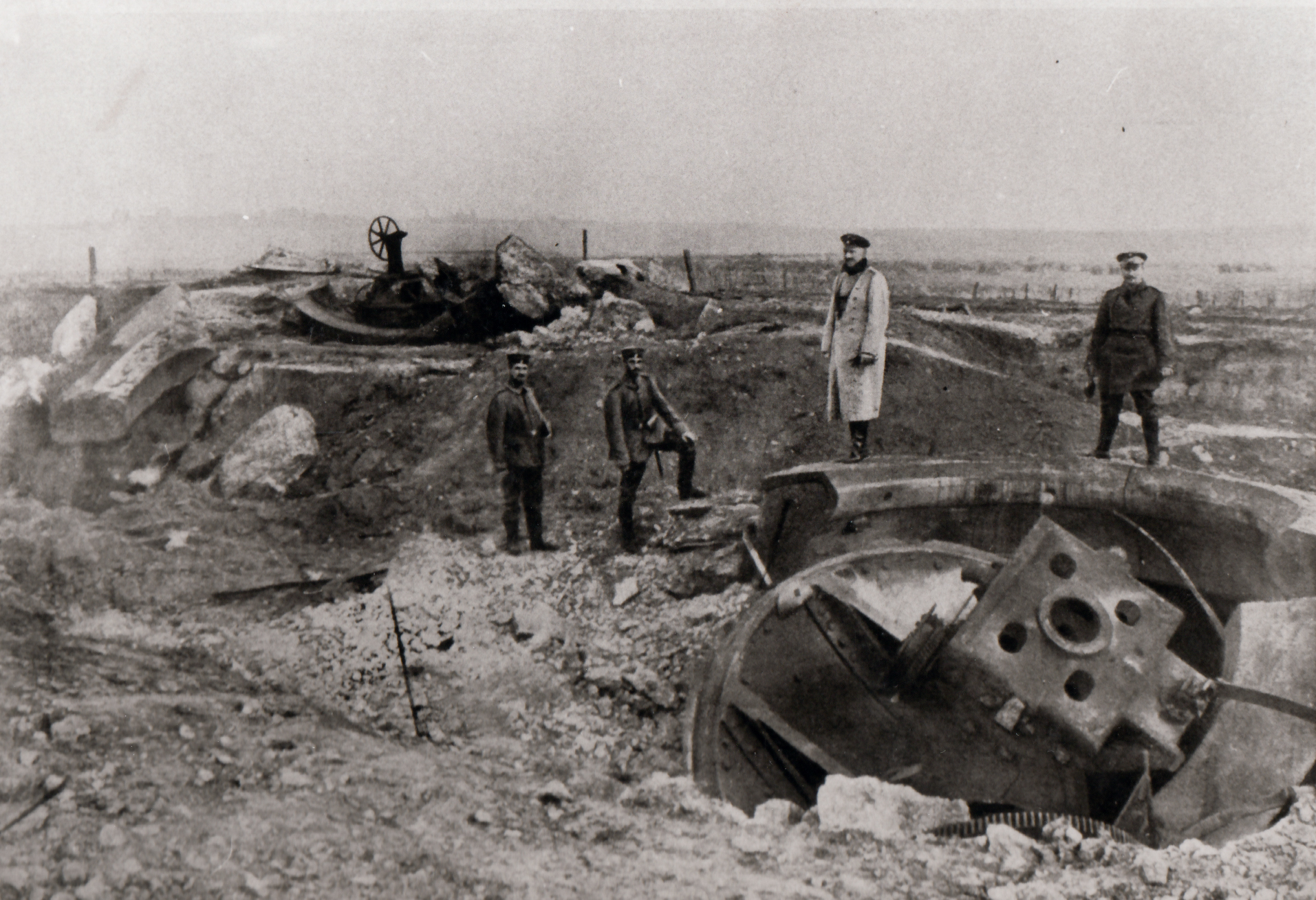
|
|
lordroel
Administrator
Member is Online
Posts: 67,966 
Likes: 49,369
|
Post by lordroel on Aug 17, 2019 6:36:40 GMT
Day 21 of the Great War, August 17th 1914The Battle of Cer continues to rage. Photo: Serbian troops on the Danube in August 1914
 SMS KARLSHURE meets up with the collier PATAGONIA, south of Barbados. The French advance in Alsace and Lorraine continues, but a dangerous gap is beginning to appear between the French First and Second Armies. With Liège taken, the German right wing resumes its advance across Belgium. The Belgian government evacuates Brussels, taking up residence in Antwerp. Asian and Pacific Theatre of the Great War
HMAS BERRIMA, an auxiliary cruiser, was commissioned into the Royal Australian Navy. BERRIMA was previously known as SS BERRIMA of the P&O Line. Members of the AN&MEF from Victoria board a train leaving Flinders St Station in Melbourne, bound for Sydney to join others aboard HMAS Berrima with the aim of taking action against German New Guinea. The 3rd Light Horse Regiment was raised in Adelaide on 17 August 1914. Although most of its recruits were enlisted in South Australia, one of the regiment’s three squadrons was composed of Tasmanians and was raised and trained in Hobart. Work of medically examining volunteers for the 10th Battalion Australian Imperial Expeditionary Force began at the Parade Ground on King William Road in Adelaide. The pay for a private was 4s a day and 1s deferred pay while in Australia and 5s a day with 1s deferred pay plus rations while overseas. Criteria included height 5 feet 6 inches and age between 19 and 38 years. Two men aged 34 and 36, both ex-servicemen, walked from Port Pirie to enlist. Eastern Front
The Battle of Stallupönen is fought between Russian and German armies and is the opening battle of the War on the Eastern Front. It is a minor German success, but does little to upset the Russian timetables. YouTube (Battle of Stalluponen August 17th - 23rd 1914)Russian 1st and 2nd Armies begin their advance into East Prussia, fulfilling Russia’s promise to its ally, France, to attack Germany from the east as soon as possible so as to divert German resources and relieve pressure on France during the opening weeks of the First World War. The Russian 1st Army, commanded by Pavel Rennenkampf, and the 2nd Army, led by Aleksandr Samsonov, advanced in a two-pronged formation—separated by the Masurian Lakes, which stretched over 100 kilometers—aiming to eventually meet and pin the German 8th Army between them. For the Germans, the Russian advance came much sooner than expected; counting on Russia’s slow preparation in the east, they had sent the great bulk of their forces west to face France. Map: Eastern Front, August 17th to August 23rd, 1914.

|
|
lordroel
Administrator
Member is Online
Posts: 67,966 
Likes: 49,369
|
Post by lordroel on Aug 18, 2019 6:16:05 GMT
Day 22 of the Great War, August 18th 1914An Austrian counterattack against the advancing Serbs fails. The Belgian Army begins to retreat towards Antwerp. Photo: The Belgian artillery falls back on Leuven pulling out of the eastern city of Tienen (pictured here). Plumes of smoke from the heavy fighting outside the town can be seen.
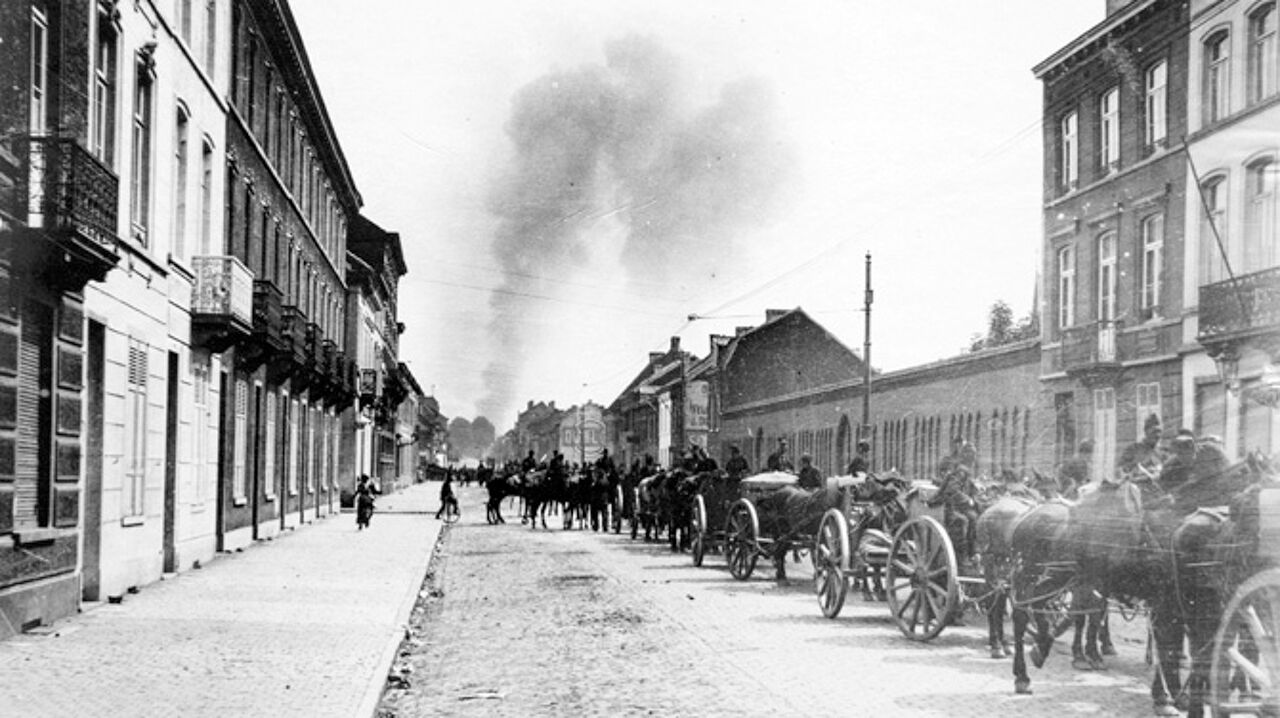 Joffre orders an attack on the German center in the Ardennes. The French advance in Alsace and Lorraine continues, with heavy fighting around Mulhouse. German forces begin to shell the town of Haelen, where Belgian units are holed up following the loss of Liége. Haelen is quickly taken, and the Germans cross the Gette River. The main Belgian force is on the other side, and they hastily withdraw north to the Dilje River. The largest action of the day is fought at Margriethe-Houthem, after which the Belgians continue to retreat. ADML von Spee, C-in-C, German East Asia Squadron (Gerrman: Ostasiengeschwader), record in his journal: ‘ The AUSTRALIA is my special apprehension-she alone is superior to my whole squadron’. SMS KARLSHURE stops British freighter SS BOWES CASTLE. The ship's master insist that his cargo of nitrates is American, but since it is a war material Captain Köhler decides to sink the ship. the crew are taken onto PATAGONIA and BOWES CASTLE is scuttled.
|
|
lordroel
Administrator
Member is Online
Posts: 67,966 
Likes: 49,369
|
Post by lordroel on Aug 19, 2019 2:43:36 GMT
Day 23 of the Great War, August 19th 1914The first group of Indian troops to go overseas sails for East Africa. The Austrian armies that invaded Serbia begin to crumble under the Serbian attacks. What starts as a retreat quickly turns into a rout. Advancing Russian cavalry encounters and engages German infantry near Gumbinnen, East Prussia. The Belgian retreat from the Gette River continues. Belgian forces make a stand at Aarschot, and hold off the Germans for several hours before retreating. Reports are made of Germans shooting Belgian prisoners and then executing 150 Aarschot citizens. United States President Woodrow Wilson addressed Congress and calls for strict neutrality: " Such divisions amongst us would be fatal to our peace of mind and might seriously stand in the way of the proper performance of our duty as the one great nation at peace, the one people holding itself ready to play a part of impartial mediation and speak the counsels of peace and accommodation, not as a partisan, but as a friend." Kamerun Campaign: Captain Ernst von Raben, commander of the German colonial garrison in Mora, surprised a British column of 50 men from Maiduguri, Nigeria with a crack force of 30 troops, driving them away from the fort. Western Front: the French capture Mulhouse again
French forces in Alsace capture Mulhouse again after heavy fighting. This time they are not greeted by cheering crowds. The city’s inhabitants experienced reprisals when the Germans recaptured the city on the 11th and now they are more circumspect. Map: The Battle of the Frontiers, August 1914.
 Asian and Pacific Theatre of the Great War Asian and Pacific Theatre of the Great War
The Australian Naval and Military Expeditionary Force leaves Sydney with 1,500 men on the newly commissioned HMAS BERIMA to capture German New Guinea. Photo: HMAS BERIMA August 1914 (Stern view at Cockatoo Island)

|
|





































